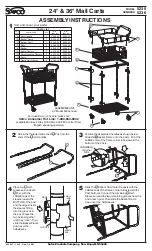
Page 6 (Revision 2.0) Copyright © 2018 GeeTramp® All Rights Reserved.
TRAMPOLINE LOCATION
–
REDUCING SAFETY RISKS
In-Ground Installation
Installation is to be done by the purchaser. The trampoline works best when installed fully
assembled In-Ground and kept separate to any retaining wall. This is the trampoline can look after
its own forces (from jumping) and the retaining wall can look after the forces from the surrounding
ground.
Correct Trampoline Positioning
For safe use of the trampoline, please be aware of the following points when selecting a place for
your trampoline:
Surface that the Trampoline is on:
1.
Make sure this is flat and level.
2.
Do not locate the trampoline on top of other objects or store anything underneath the trampoline
Note: Children have been injured while bouncing on trampolines and contacting objects
underneath.
The area surrounding the Trampoline:
Even though the trampoline is designed to be used at ground height, it is prudent to note that there
is no net to prevent the user accidently landing outside the trampoline perimeter, this makes the
surrounding area a critical consideration to prevent injury.
1.
Make sure this has impact attenuating properties such as grass or approved safety pads. If
placing the trampoline near concrete or similar hard surfaces, make sure soft fall protection is
put in place surrounding the trampoline.
2.
Maintain a minimum clearance of 5m on all sides of the trampoline.
3.
Surfaces to consider minimising potential landing injuries are gymnastic floor padding, sand
and other designed impact absorption materials.
4.
Do not place the trampoline near other surrounding hazards that can cause serious injuries
when users exit the trampoline, some hazards to consider;
a)
impact potential onto unprotected hard surfaces like concrete, bitumen, rocks, brick
walls, fences etc.
b)
impact, cuts and stab potential from inherently dangerous surfaces if landed onto or
against e.g., glass panels, windows.
c)
falls potential from uneven ground surfaces.
d)
falls potential from multilevel ground e.g. stepped level back yard.
e)
impalement potential items e.g. garden utensils, push bikes, fence tops etc.
f)
strangulation or hanging potential e.g. washing lines, trees.
g)
slips or drowning potential from wet area’s e.g. ponds, pools etc
.
h)
collision potential by going into the path of mobile equipment and vehicles e.g. cars.
i)
collision potential from or with other playground equipment e.g. cubbies, slides, swing
sets etc.
j)
collision potential with other people or pets nearby.
5.
Keep a minimum of 5m overhead clearance when measured from the trampoline bed height
to prevent users inadvertently contacting overhead hazards such as electric wires, tree limbs,
clothes lines and other possible hazards.
6.
Make sure the area has good lighting.






































